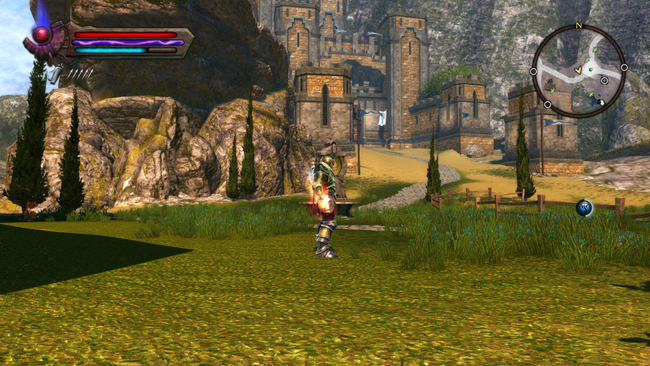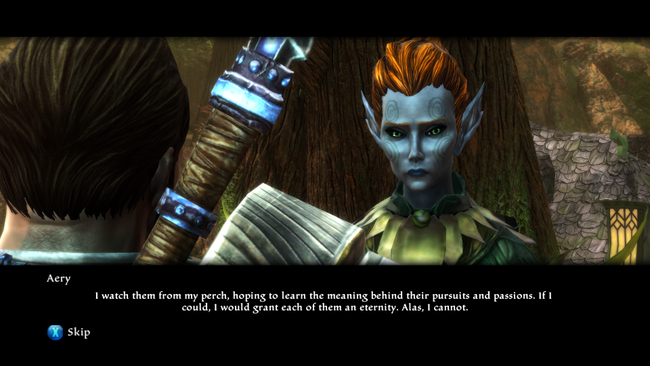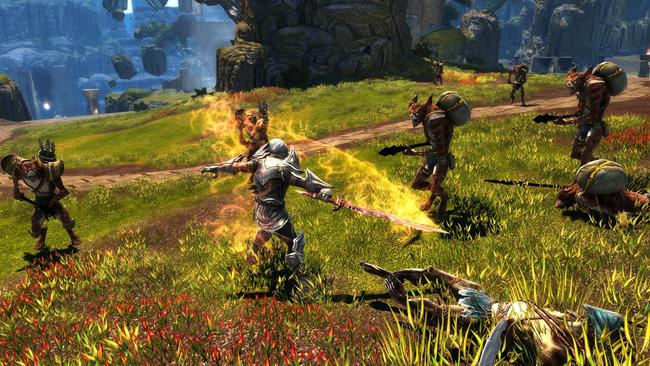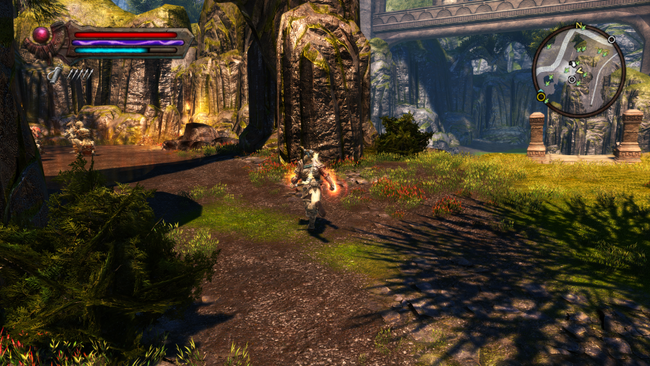
Kingdoms of Amalur: Re-Reckoning Review
You wake up on top of a pile of rotting corpses in a dark, damp cavern. You can't remember anything: where you are, how you got there, or anything besides your name. You get to your feet, steady yourself, and try to solve this strange mystery you find yourself in.
Navigating through the stench and decomposing skeletons, you soon meet a 3-ft tall person - a gnome - who is completely aghast at your presence. You were killed! You shouldn't be alive, but here you are, breathing and with a pulse. You've defied the ultimate fate, and now, you have the power to change not only your fate but that of the entire world of Amalur.
Fate is a confounding thing. Kingdoms of Amalur not only uses the concept as a lynchpin to its narrative premise, but the game itself has seemingly defied its own fatal demise with a surprising remaster. Only a few short years ago it seemed Amalur would never breathe again.

Kingdoms of Amalur: Reckoning is a game with a strange history that now finds itself in a weird place. Originally in development at Big Huge Games under the original THQ before 2010, the game wasn't always set in the Amalur universe. Only after it was acquired by the now-defunct 38 Studios did the RPG get retooled to work as an introduction to the Copernicus MMORPG that the studio was working on at the time. Kingdoms of Amalur: Reckoning ultimately released in 2012, and despite selling over a million units and some modestly good critical reception, 38 Studios filed for bankruptcy a few months later. Copernicus never saw release. Amalur reached its end only shortly after it began.
Now eight years later, the IP is in the hands of THQ Nordic (which is a newer, different company that acquired the THQ trademark, funny how that works), and a remaster titled Kingdoms of Amalur: Re-Reckoning is now available for modern platforms. Not only that, but a new expansion will launch next year, so against all odds, the brand somehow has a bit of a pulse.
As it happens, RPG Site never had a chance to review Kingdoms of Amalur: Reckoning's original release back in the day, so this remaster allows us to make up for that in some way. This is my first experience with the game, so I can't fully speak from experience how exactly the remaster touches upon aspects of the original. Instead, I went into Re-Reckoning with the understanding I was playing a 2012 game in 2020.

The Amalur universe was created by R. A. Salvatore, a fantasy author who wrote a 10,000-year history for world. As such, Kingdoms of Amalur: Reckoning is chock full of lore: people, places, and events. There are 100s of named NPCs that can offer insight on their personal stories, location, and backgrounds. There are nearly 200 lorestones that each offer short anecdotes or other quotes that elucidate how certain regions were created, factions were formed, or cities founded. For those who love to dig deep into fantastical histories, Amalur certainly serves up a lot of it. It is admittedly a strange situation that there is currently no other connected media that touches on this history outside of Kingdoms of Amalur, but maybe this will change in the future.
The world of Amalur is most easily described as the coexistence between mortal people and the immortal Fae. Fae are natural, magical creatures that cannot die permanently, yet still live amongst mortal beings. Some Fae view mortals, such as Humans and Alfar, as lesser beings, while others view them as a sort of strange curiosity. The most aggressive of the Fae are known as the Tuatha, an army whose mission is to rid the world of mortal beings and act as the game's main antagonistic force.
The amount of world-building and lore in Kingdoms of Amalur certainly surprised me. It's genuinely impressive how much of the world history was thought through and some interesting wrinkles in the rules of magic and fate help to let it stand apart from other fantasy worlds. Sadly, while there is a lot of world history to dig through, the game does a poor job portraying the world and involving it within Amalur's storyline. The direct narrative involving the player character is not nearly as interesting as the world around it, but it's still a decent first step into this universe.

However, in the actual game, a lot of the characters in Amalur are tied to sidequests. There are more than 250 of them in the game, and most of them boil down to basic tasks. The vast majority of quests simply involve delivering an item elsewhere, taking out a specially named enemy somewhere, or going through a quick samey-looking dungeon. Put shortly, the sheer number of quests often dilutes them to feeling like chores more than anything meaningful. Additionally, almost none of the quests have any decision making to speak of outside of a scant few key exceptions. This makes quests feel more like a rote to-do checklist more than anything.
The most interesting quests in the game are the ones tied to various factions. These account for about 50 of the total number of sidequests, and each questline offers a small sidestory and conflict separate from the main campaign. You learn about the tragic story of the mysterious Maid of Windemere - a foe to the Fae House of Ballads. Another faction quest elucidates some of the history between the Warsworn mercenaries and monstrous Niskaru. While the actual tasks performed in these quests don't differ too much from the numerous other quests, the narrative throughline for each faction makes them marginally more interesting.
Many quests will task you to delve into various dungeon areas to complete. Sadly, many of these dungeon areas feel ripped from the same formula, which is usually a series of caves connected by samey looking tunnels. A tapering of the sheer number of quests and dungeons could have gone a long way to improve the game's balance and variety, but instead, it just feels overstuffed in that regard. Get those podcasts ready if you plan on completing most of these quests.
This bloated MMO-like quest design is definitely the weakest element to Kingdoms of Amalur: Reckoning as an RPG. Sometimes a little bit of grindy busy work can be acceptable to explore areas and give an excuse to engage with the combat system in various ways. However, the overabundance of menial quests and dungeons waters down the whole.

Combat in Kingdoms of Amalur is fairly simple, but effective. It's an action RPG where you can equip two different weapons to your character, with each assigned to a different face button. By adjusting the timing or holding of these buttons in battle, you can perform a variety of moves in real-time. Three different skill trees are available, which effectively boil down to physical tank, finesse stealth, or magic. You can either go all-in on one of these trees or mix it up however you feel.
It took a little bit of time for me to get used to the fact that there is no sort of enemy lock-on, but otherwise combat feels fluid and responsive. Once again, due to the sheer number of quests, you can find yourself mashing through combat often, and the enemy variety is a little bit lacking, but it's a solid foundation that works as intended. You can also change up your skill allocation fairly readily at the cost of a small fee, so trying out different combat styles is easy to do.
As a visual remaster. Amalur looks pretty good. I haven't played the original version, but THQ Nordic states that many textures have been touched up and the rendering engine has been improved. The one place where the remaster shows its age is in the character models, especially faces. While most of the game's artstyle cleans up pretty well, NPC discussion is an easy reminder that this game is nearing ten years old.

The remaster does add a few things more than just a visual touch up, though. For example, the game's storage chest capacity has been updated from 155 to 300 items - a welcome improvement. Loot generation has been tweaked so that items you find in chests or off enemies are more likely to be useful for your character build at your level. You can also assign a total of 8 active skills to shortcuts now instead of just 4, which makes using your full arsenal of of abilities easier to do.
Finally, a 'Very Hard' mode has been added, which should aid in making the game more challenging, as the original was known for being a bit on the easy side. To note, I played on the game on 'Hard' mode, which was moderately challenging initially but significantly eased up around the half-way point.
My experience with the remaster was somewhat riddled with glitches and crashes. My game, played on PC, would often freeze when I accessed the quest menu, and fast-traveling from one location to another would occasionally crash my game. Sometimes character models would not appear (only their clothing), and once my character's legs disappeared entirely such that I was a floating torso and helmet. One of the most annoying glitches was that one region of the map would never display correctly, only showing icons instead of the map itself, which basically rendered it worthless. I'm not sure which of these glitches might have existed in the original game and which are new to Re-Reckoning, but hopefully things can be ironed out shortly either way.
As of right now, Kingdoms of Amalur is a good introduction to a universe that doesn't have any other entries. The fluid combat is brought down a bit by overstuffed quest design and repetitive dungeon areas, and the front-to-back storyline is a little basic, but it offers a solid foundation to a world whose fate is once again uncertain.